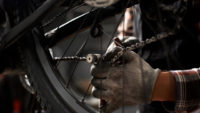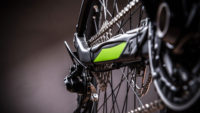
At A Glance
Truing a mountain bike wheel can turn you from a beginner biker into a professional. Learn how to do it with the quick and easy steps in this guide.
Whether your wheel is jaywalking or turned into an egg-shaped mess, truing can rescue it.
Don’t know how to true a mountain bike wheel?
Read on!
How to True Your Mountain Bike Wheel?
Put the Wheel in a Truing Stand
Don’t have a truing stand?
You can set up your bike on a repair stand and attach a zip-tie to the seatstay. Then cut the zip-tie so it is a millimeter away from the rim. This will help you see where the wheel is out of alignment.
Remember to fix any parts that are inconsistent with the rest of the wheel. Follow this for adjusting the tension in the spokes and truing the wheel as well.
Check the Tension in the Spokes
- Use a tension meter to check the tension in the spokes
- Squeeze the handle on the meter and put the spoke where the dotted line is
- Release the handle and the meter will show you the spoke tension
- Repeat this process for all the spokes on one side of the rim until you find a spoke that is out of the average tension range
If you don’t have a tension meter, use your fingers to tap on the spokes and listen for inconsistencies in tune.
Adjust the Tension on the Spokes
Turning a spoke key clockwise tightens the spokes, whereas turning it counterclockwise loosens the spokes.
- When you find a loose or tight spoke, adjust it using a spoke key for rims with nipples on the outside.
If your wheel has nipples on the inside, remove the tire and rim strip from the rim. Then use the appropriate spoke wrench for internal nipple size to tighten the spokes.
Also, make sure to only turn the spoke keys a quarter at a time.
Lateral Truing
Lateral truing is needed when your wheel jaywalks left to right. What you need to do here is balance the tension on both sides of the rim.
Releasing tension from the spokes on the drive side will pull the rim to that direction. Similarly, increasing the tension on the spokes on the drive side pushes the rim to the non-drive side and vice versa.
- Tighten the brake or gauge on the truing stand. Leave a small distance between the outer edge of the rim and the gauge so that they barely touch.
- Spin the wheel to find the part that makes contact with the gauge. If you’ve got a zip-tie, then identify the part that touches the zip-tie.
- Tighten the spokes on the side that makes contact with the gauge or loosen spokes on the opposite side of the rim
- Keep spinning and checking the wheel to get it as even as possible
- You’re done when the distance between the rim and the gauge or zip-tie is even throughout
Radial Truing
If your wheel has started to become egg-shaped, then you’re probably facing a flatspot problem. This means you need to radially true the wheel.
Increasing tension on the spokes will push the rim higher, and releasing tension will make it drop lower.
- Tighten the zip-tie or indicator on the truing stand to make it sit directly below the rim. Leave a small distance between the rim and the indicator so that they barely touch.
- Spin the wheel to find the part that makes contact with the indicator
- Tighten the spokes on the side that makes contact with the indicator
- Keep repeating this until the rim no longer touches the indicator
Final Thoughts
Identifying an out-of-balance wheel is not an easy task, but one that can ensure your wheel stays durable for a long time, especially on an MTB. So, make it a habit to true your wheel once in a while.
Worried you’ll forget how to true a MTB wheel?
Save this guide until you memorize it!





